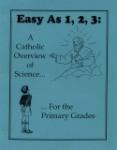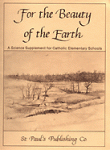General Resource
Easy As 1, 2, 3
This program provides families who like to use living books with a Catholic framework from which to study science. It is not a textbook but rather is 40 pages, of which approximately half are outlines, that are three hole punched and ready to go into your notebook. The parent that uses this will find the eleven units of science outlined very handy for creating their own program and clearly laid out so that they can tuck personal notes and activities into their notebook using the 40 pages as their point of organizing.
The Pharaohs of Ancient Egypt
Let the Authors Speak
Brother Joseph: The Painter of Icons
Tom was an ordinary boy who loved being outdoors and drawing whatever he saw. Although Tom found school distasteful, his teacher, Sister Aquinas, saw artistic talent in him and encouraged him and lent him books on religious art. He discovered that his favorite artist was Fra Angelico. He attended a high school seminary and discovered that he wanted to be a monk. There he becomes Brother Joseph and finds that his artistic talents are put to good use.
Whigs and Tories
This is an extensive reading list, from a Catholic perspective, on materials relating to or taking place at the same time as the American Revolution. The extensive introduction gives tips and ideas for studying the revolution, choosing books, and how to proceed. The list is broken up into the following categories: Grades K-3 Series, Grades K-3 Individual Titles, Grades 3-6 Series, Grades 3-6, Individual Titles, Grades 5-Up Series, Grades 5-Up Individual Titles, Grades 7-Up Series, Grades 7-Up Individual Titles and Grades 10-Up Individual Titles.
For the Beauty of the Earth
Like many Catholic Home schooling families, providing a Catholic education was number one on the list of reasons my husband and I wanted to home school. In addition, we wanted a rigorous education, and one that emphasized the beauties of truth and love. Translating these goals into a curriculum is an on-going challenge. Sometimes the books that do a good job presenting a particular subject do it without the light of the Faith. Other times, books that are "solidly Catholic" are also unattractive and uninspiring. We have had to compromise in a lot of areas.
Linnea in Monet's Garden
This book is a clever way to introduce children to the works and life of Claude Monet and help them to start appreciating the works of the Impressionists. "Linnea" is a little girl with a love for art and flowers who travels with her friend and neighbor Mr. Bloom (a retired gardener) to France to visit the restored estate of Claude Monet and the museums displaying his art. Besides the illustrations of this story, there are reproductions of some of Monet's paintings, old photographs of him and his family, and photographs of what his estate looks like today.
A Child's Book of Prayer in Art
This book is designed to help your child discover the lessons present in many fine works of art. The inside cover explains "In this, her first book for children, Sister Wendy has selected paintings that can speak to children, illustrating the important values of life, such as love, respect and forgiveness.








